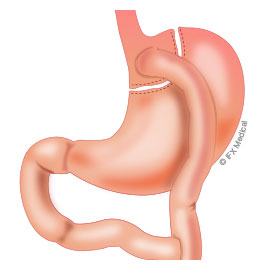Weight loss surgery featuring minimally invasive or robotic assisted surgical procedures.

The gastric bypass procedure is the most commonly performed bariatric procedure. Most people experience a weight loss of between 60-70 percent of their excess weight two years following a gastric bypass procedure.
Gastric bypass surgery promotes weight loss by:
During the gastric bypass procedure, the stomach is divided, thereby creating a small gastric pouch that acts as the true stomach. The lower part of the stomach remains in place, but food will no longer enter the chamber as part of the digestive process. The small intestine is re-routed so it is attached to the smaller pouch, thereby allowing food to bypass the larger portion of the stomach, which enhances weight loss.
As a minimally invasive procedure, gastric bypass is performed laparoscopically. This type of procedure is performed through specialized tools and robotic surgery. The entire procedure is performed through minor incisions in the abdomen. This reduces recovery time following surgery, as well as post-operative pain.
Gastric bypass surgery is highly recommended for those who have struggled with obesity for an extended period of time, who have tried losing weight through other means without success, and those who are faced with obesity related diseases such as heart disease or hypertension.
Gastric bypass surgery can reduce your risk for health conditions such as:
Duodenal Switch / SADI-S
Gastric Sleeve Surgery
Gastric Bypass Surgery
Gastric Balloon